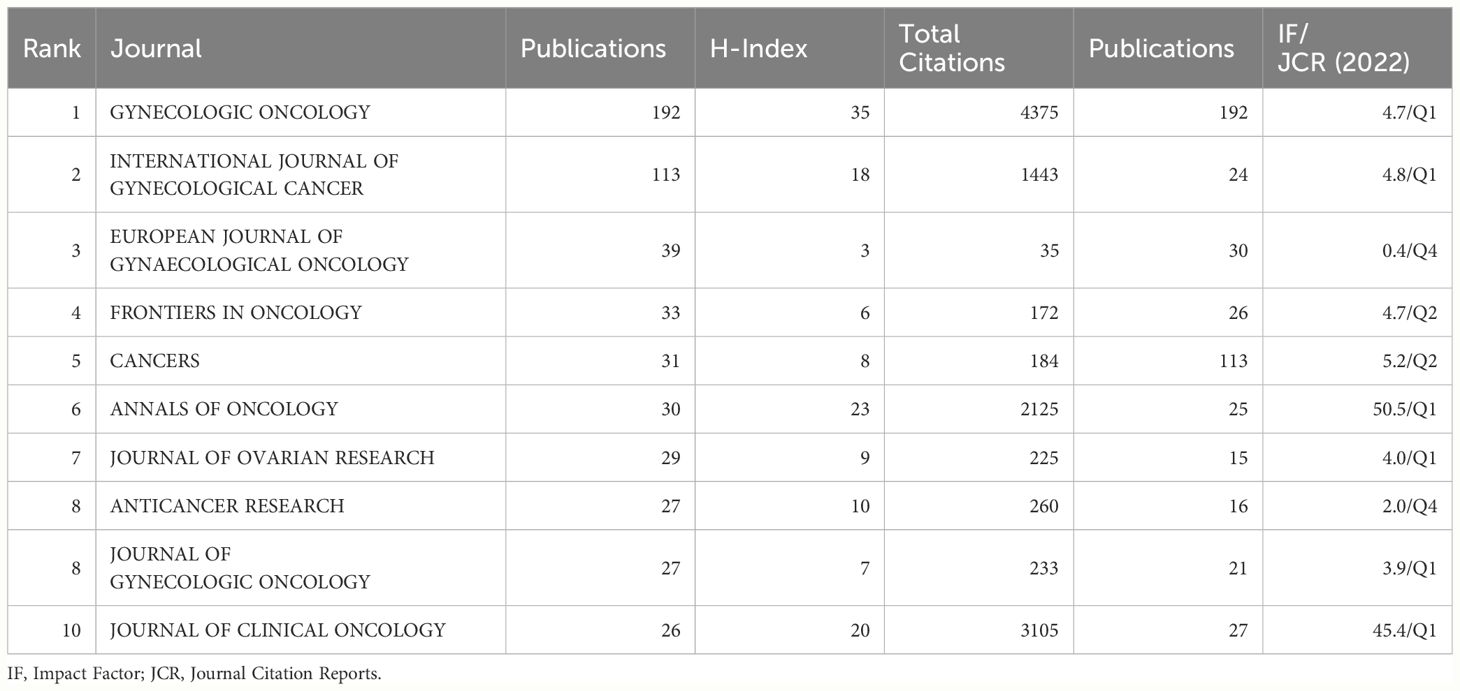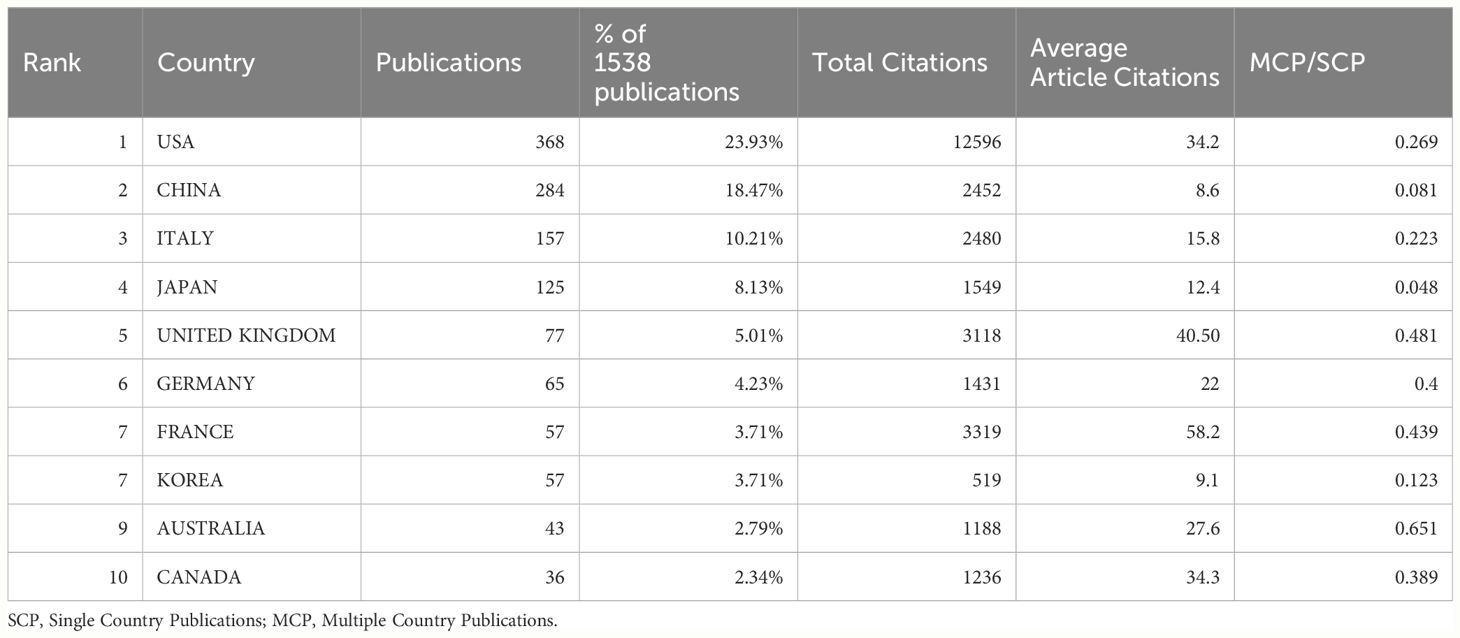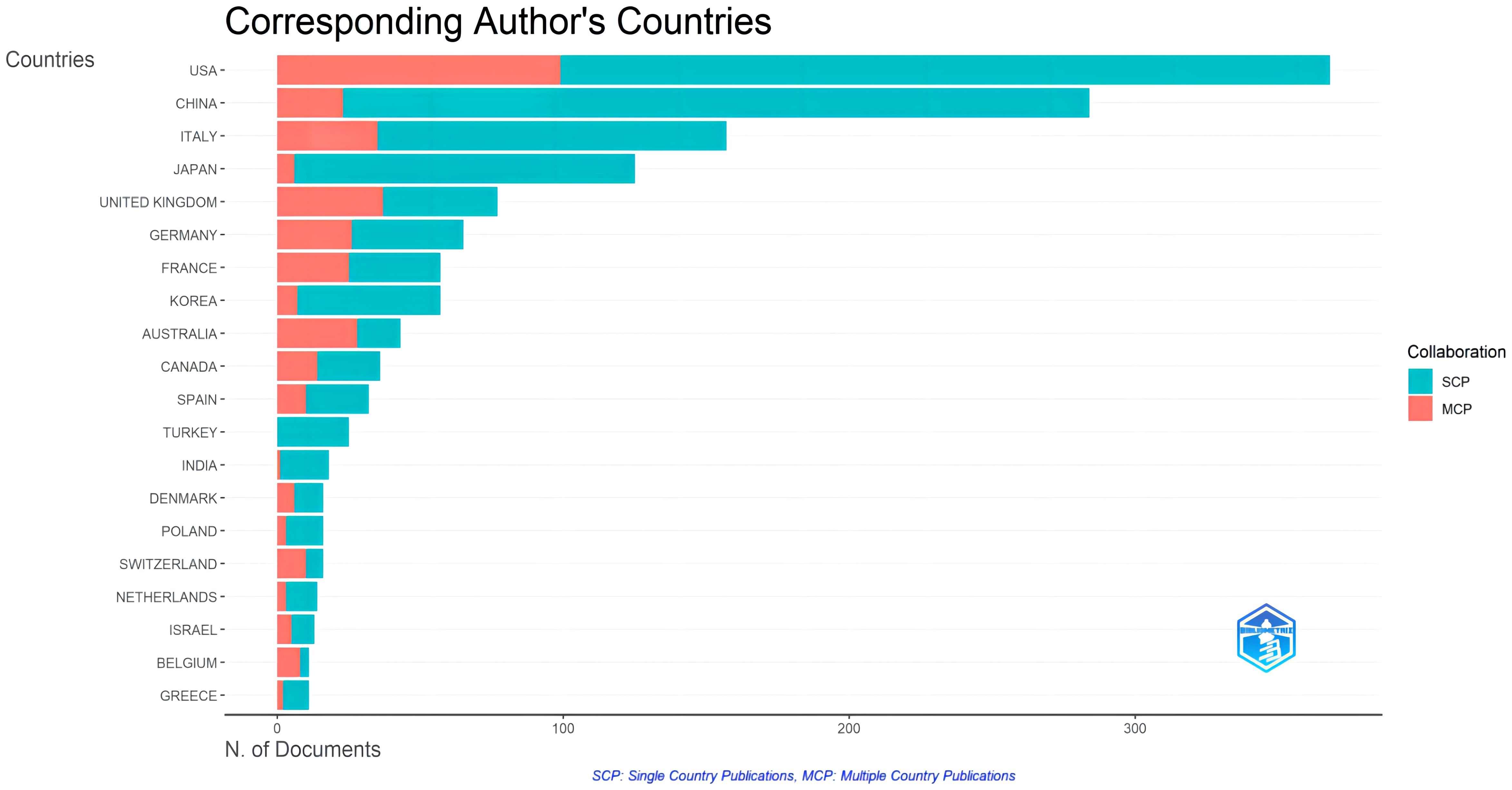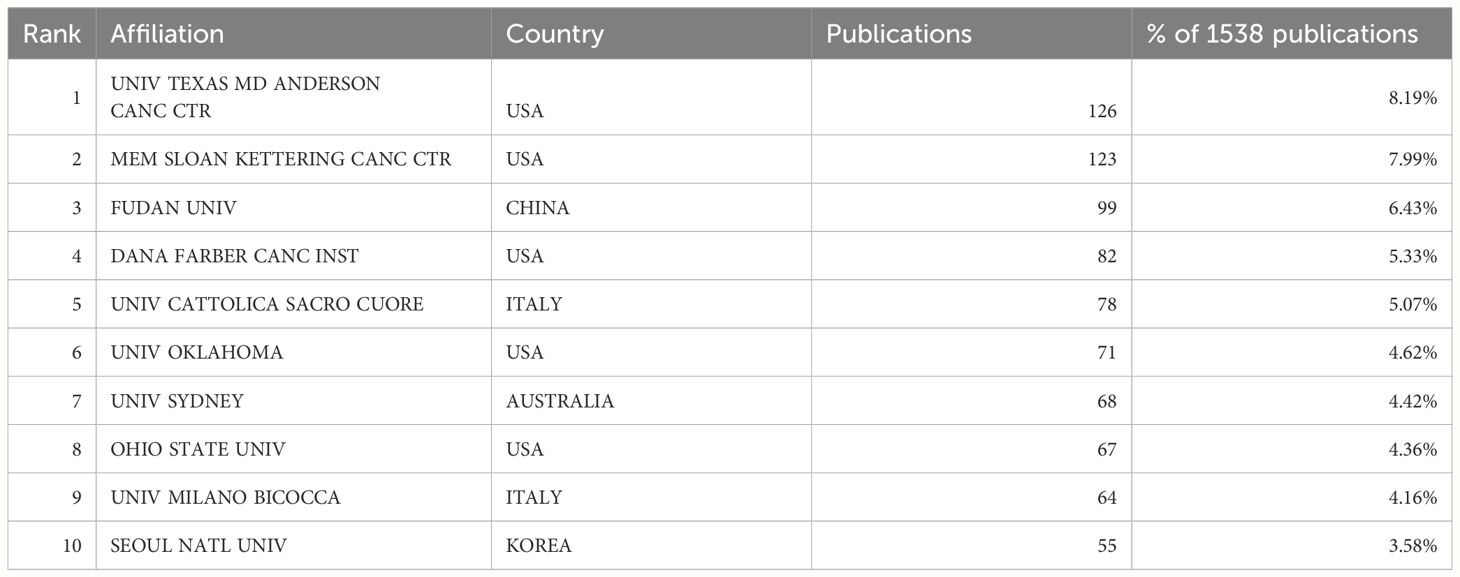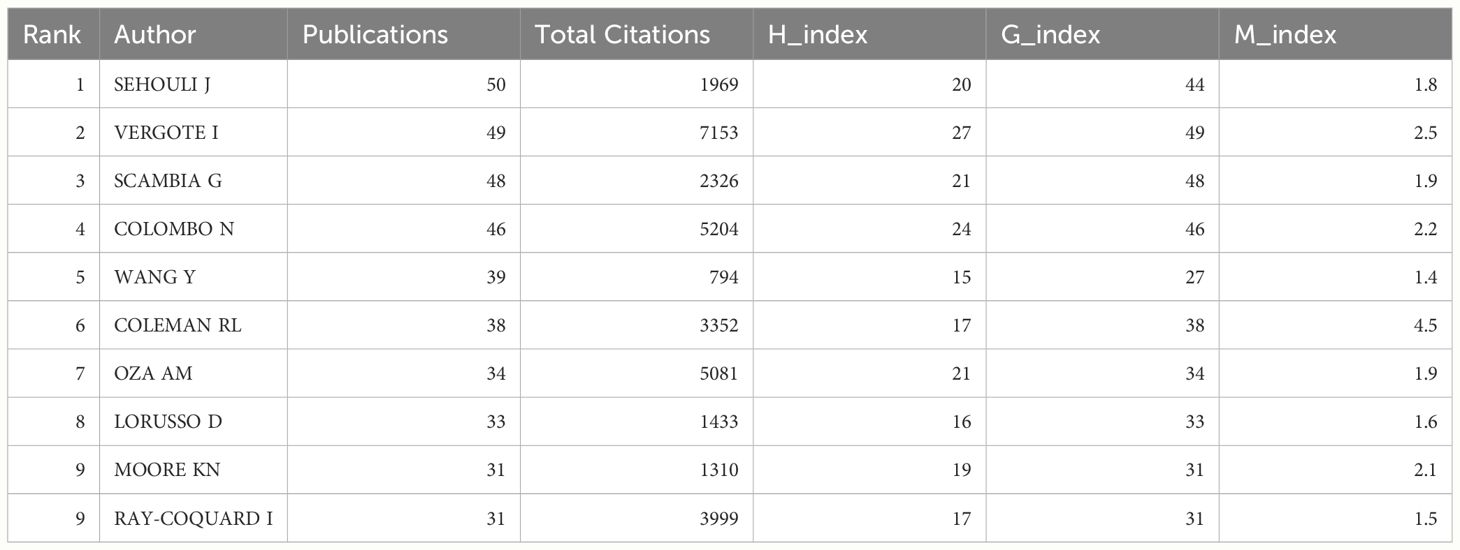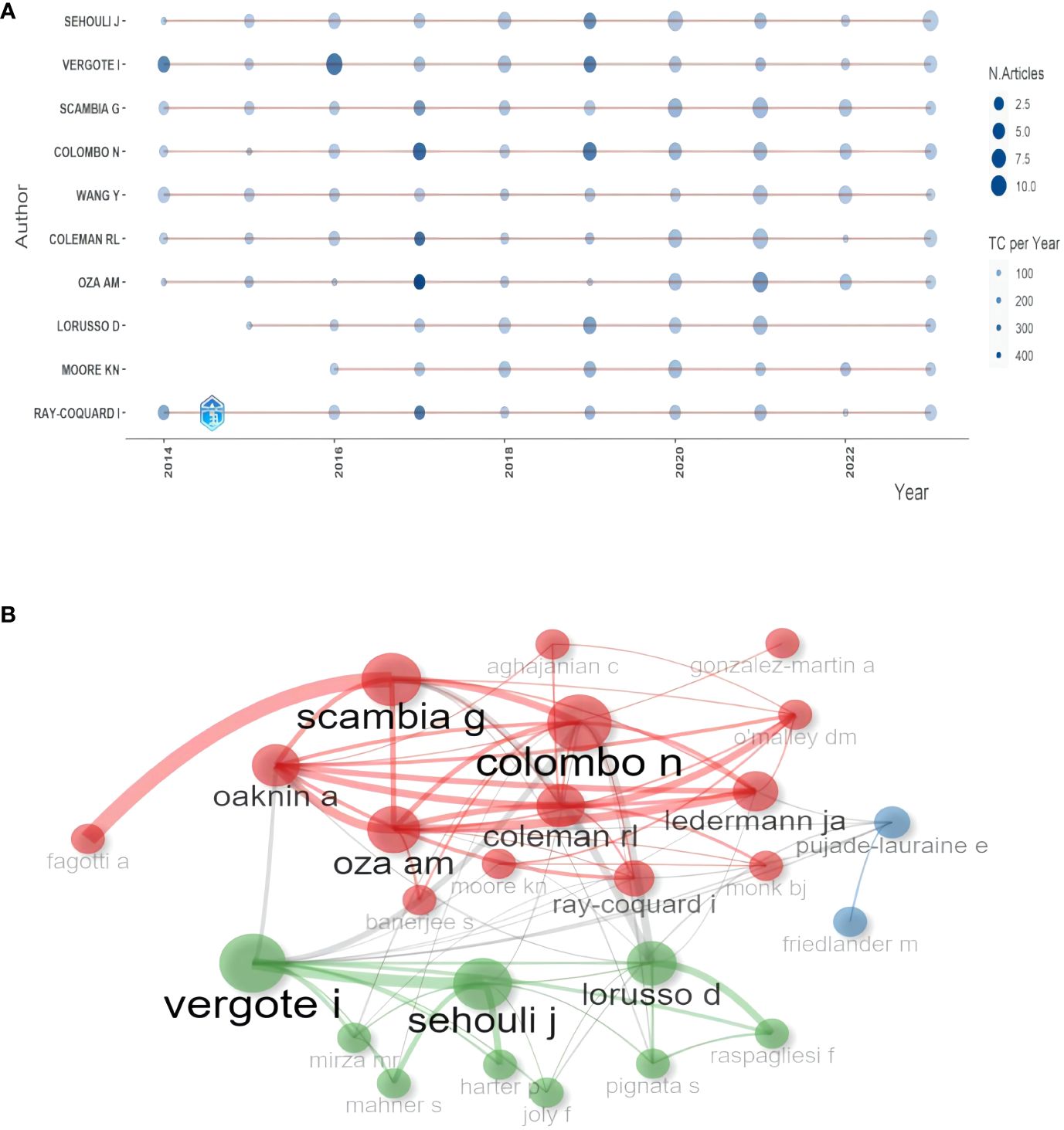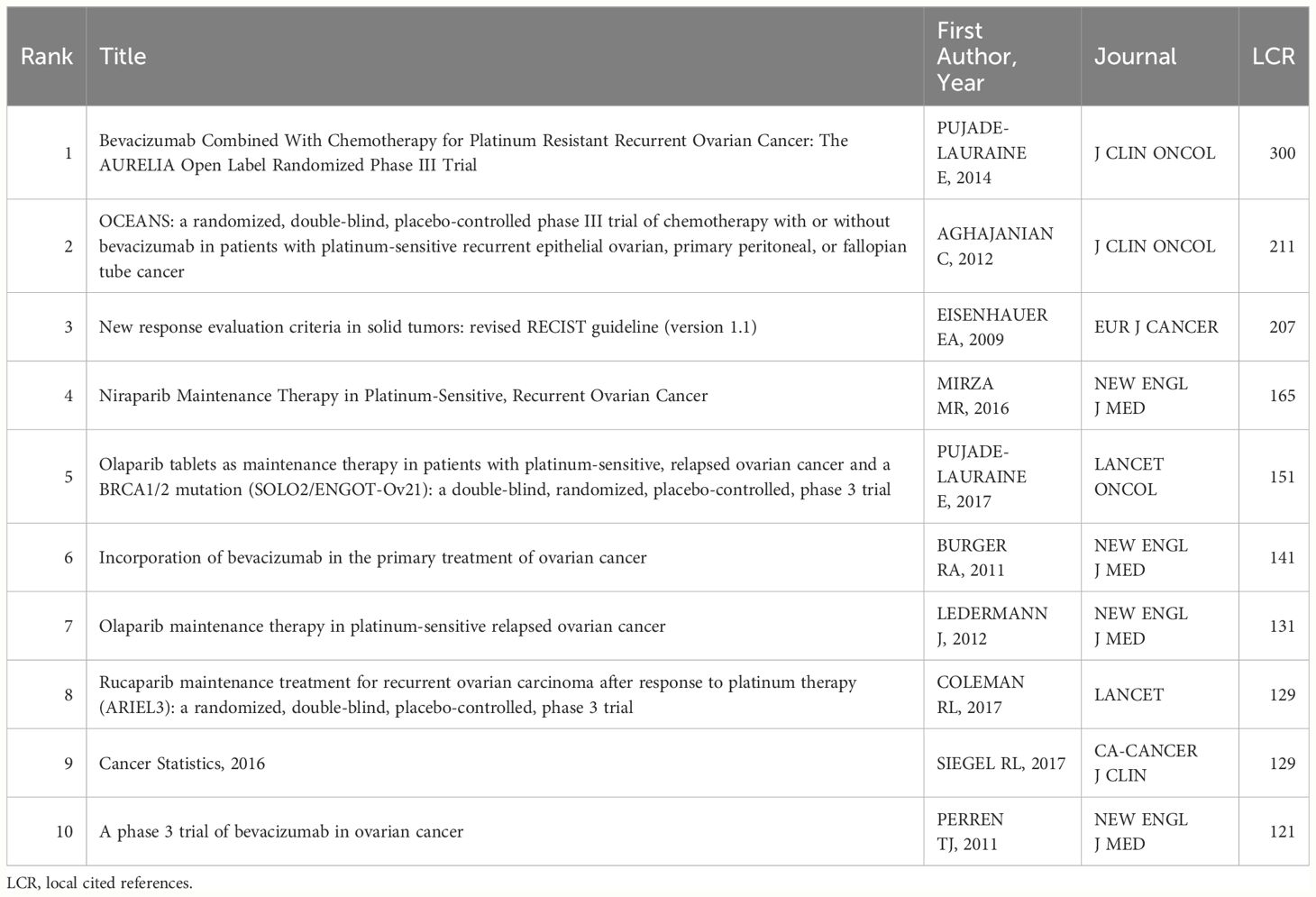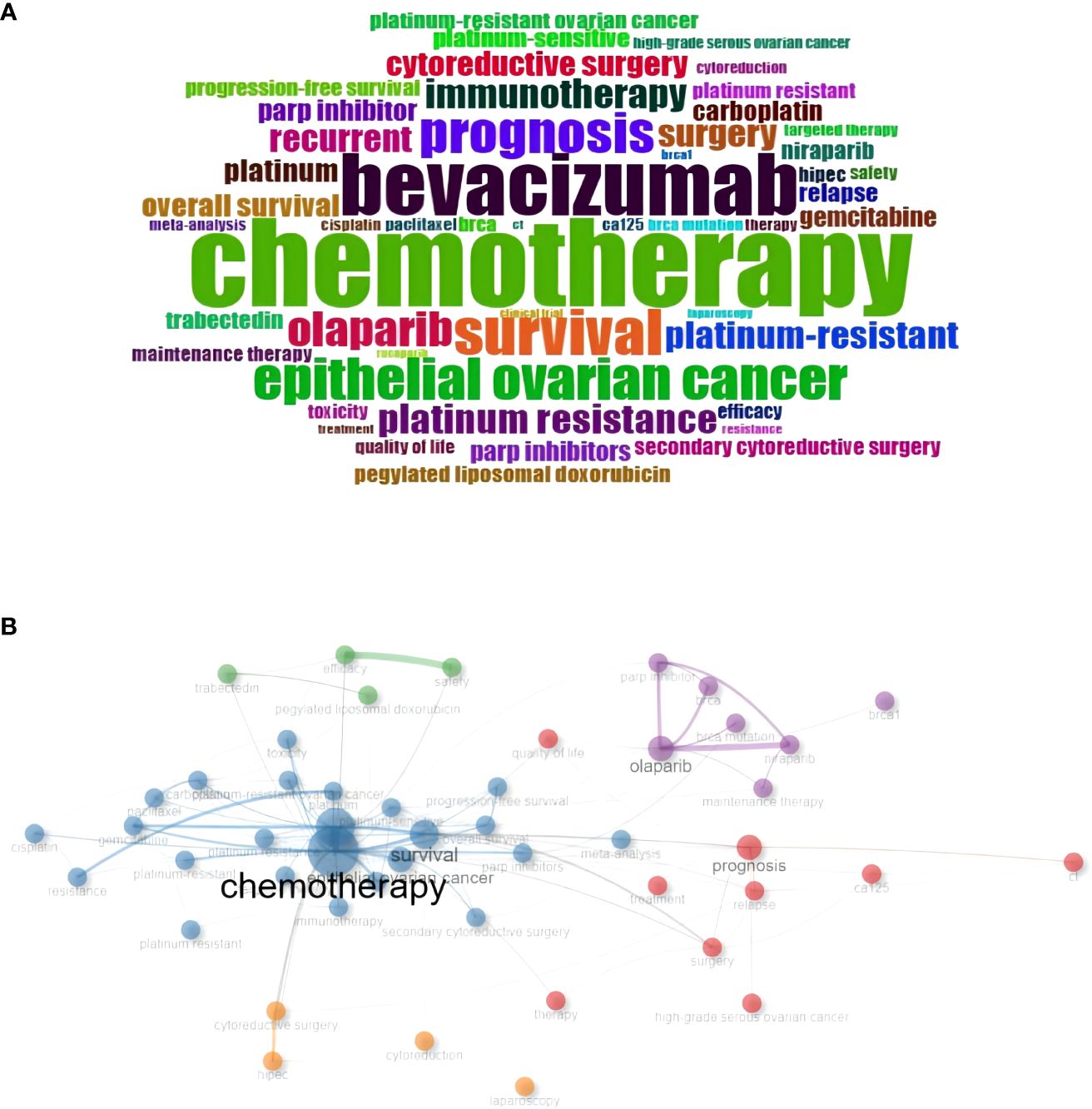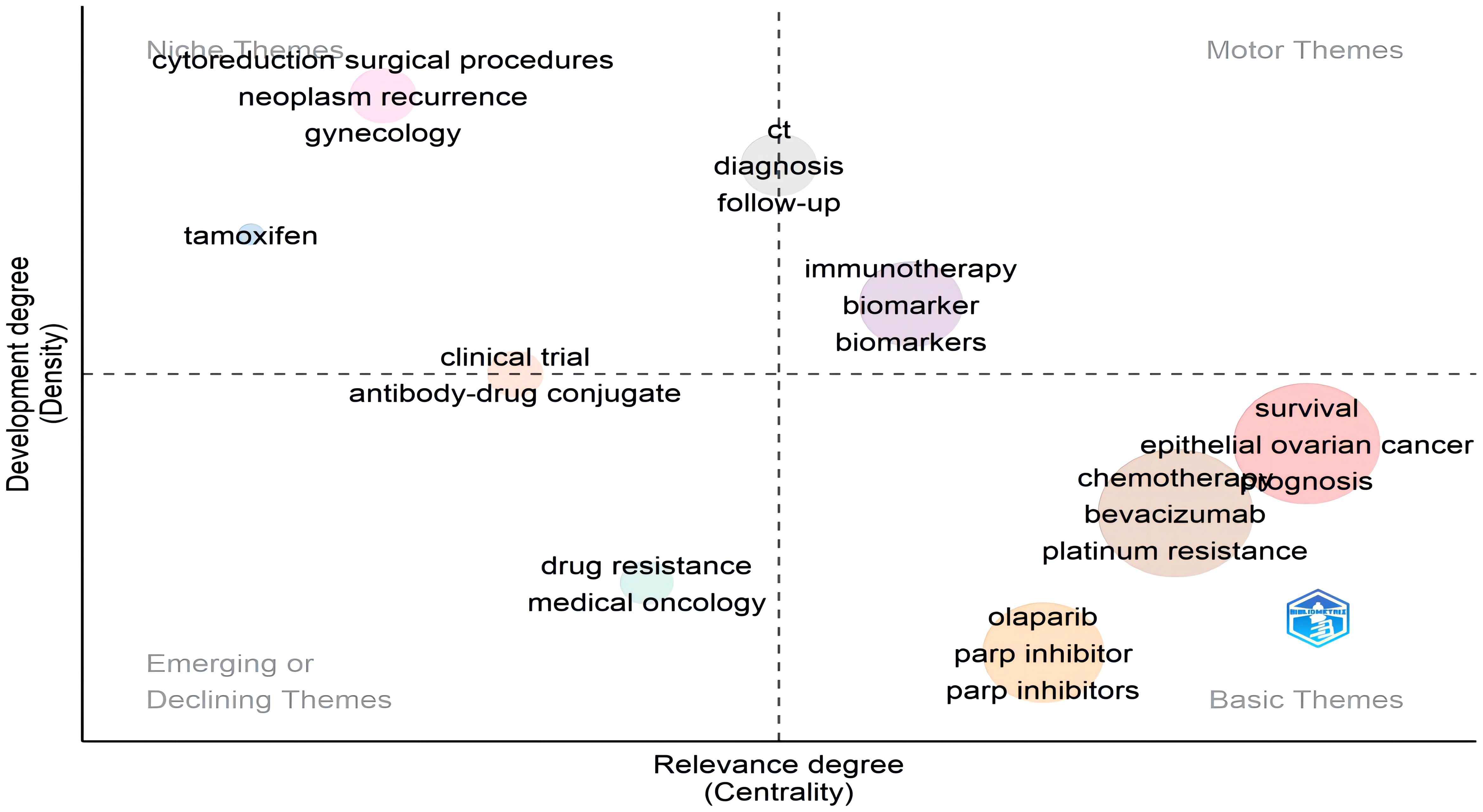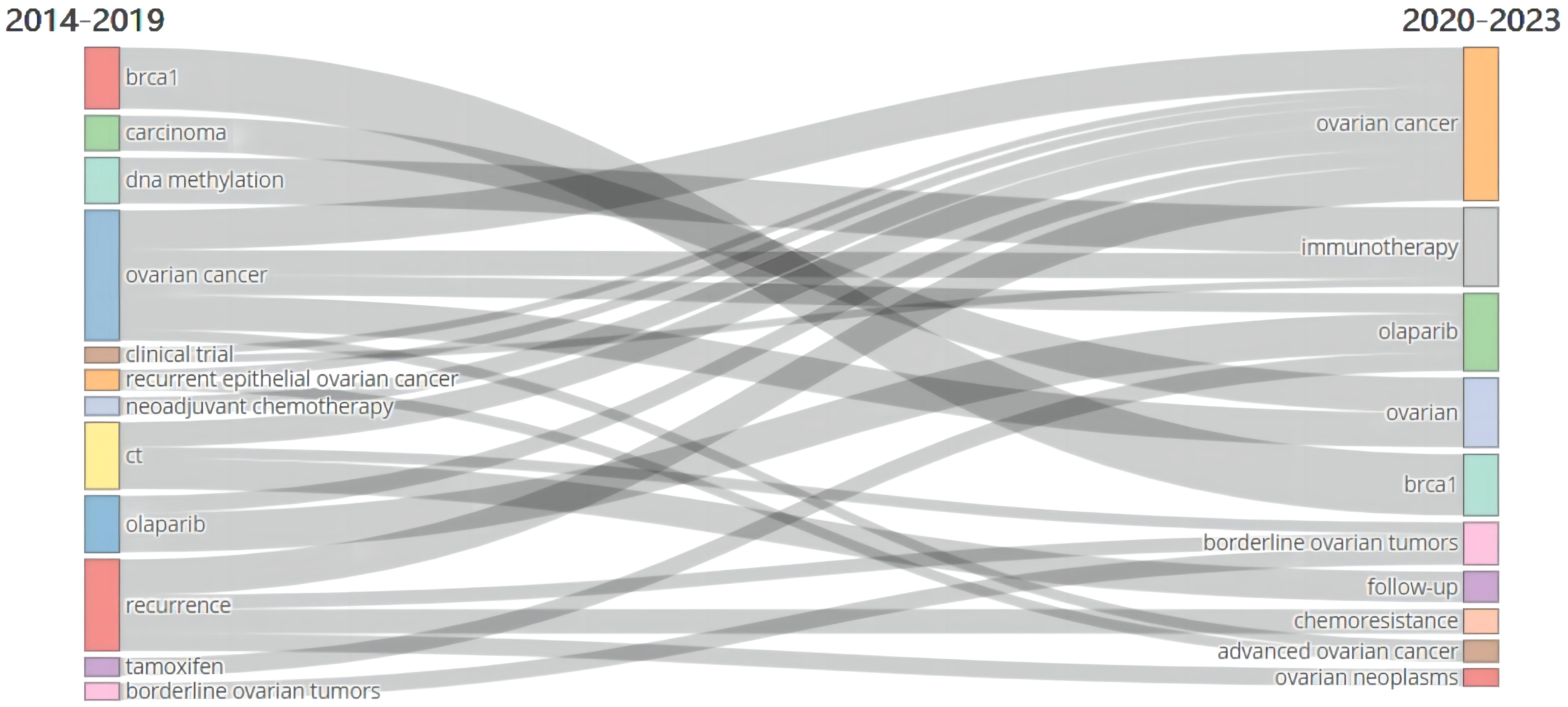- Department of Gynecology, The Affiliated Jiangning Hospital of Nanjing Medical University, Nanjing, China
Introduction: Recurrent ovarian cancer (ROC) presents a dismal prognosis, persistently devoid of efficacious therapeutic strategies. Over the past decade, significant shifts have transpired in ROC management, marked by the identification of novel therapeutic targets and advancements in biomarker research and innovation. Since bibliometrics is an effective method for revealing scientific literature, we conducted a bibliometric analysis of literature pertaining to ROC. Our exploration encompassed identifying emerging research trends and common patterns, analyzing collaborative networks, and anticipating future directions within this clinical context.
Methods: We conducted a search in the Web of Science Core Collection (WoSCC) to acquire relevant articles as our dataset, which were then exported using R-Studio-2023.12.0–369 software. The Bibliometrix R package was utilized to perform visual analyses on countries, institutions, journals, authors, landmark articles, and keywords within this research field.
Results: A total of 1538 articles and 173 reviews published between 2014 and 2023 were eventually retrieved. The annual growth rate of scientific production was 4.27%. The USA led the way in the number of published works, total citations, and collaboration. Gynecologic Oncology was the most favoured journal in this research field. Vergote I from the University Hospital Leuven, was the most influential author. At last, the most prominent keywords were “chemotherapy” (n = 124), “bevacizumab” (n = 87), and “survival” (n = 65). Clinical outcomes (prognosis, survival), chemotherapy, bevacizumab, and PARP inhibitors (olaparib, niraparib) represented the basic and transversal themes, while antibody-drug conjugate (ADC) and drug resistance were emerging themes. Cytoreduction surgical procedures and tamoxifen were niche themes, while immunotherapy and biomarkers were motor themes and had high centrality.
Conclusion: The trends in the ROC research field over the past decade were revealed through bibliometric analysis. Platinum resistance, ADC, and immunotherapy have emerged as the current prominent research topics.
1 Introduction
Ovarian cancer is the third most common gynecologic malignancy worldwide, with its mortality rate also increasing annually (1, 2). The lack of effective screening methods for early-stage ovarian cancer results in 80% of diagnosed cases being in advanced stages, particularly epithelial ovarian cancer (EOC) (3, 4). Cytoreductive surgery followed by platinum-based adjuvant chemotherapy constitutes the cornerstone of initial treatment for ovarian cancer (5, 6). However, recurrence of ovarian cancer appears to be inevitable, with 70% of EOC cases experiencing recurrence within three years postoperatively (7).
Recurrent ovarian cancer (ROC) continues to pose significant challenges for gynecologic oncologists, requiring a delicate balance between limited treatment options and considerations of efficacy and quality of life (8). Particularly for patients with platinum-resistant recurrent ovarian cancer, the lack of potent treatment options often results in poorer prognosis (9).
Over the past decade, significant changes have occurred in the management of ovarian cancer with the discovery of new treatment targets and advances in the study and innovation of biomarkers, such as the identification of the breast cancer BRCA gene and tumors exhibiting homologous recombination deficiency (HRD) (10–12). New treatment modalities in the fields of poly (ADP-ribose) polymerase (PARP) inhibitors, immunotherapy, and hyperthermic intraperitoneal chemotherapy (HIPEC) have the potential to alter the treatment paradigm for ovarian cancer (13–16). These advancements also bring forth more possibilities for the treatment of recurrent ovarian cancer. Therefore, it is particularly important to describe and analyze the current status, progress, and trends in research on ROC worldwide.
Bibliometrics is a tool for studying the production, dissemination, use, and impact of scientific and academic literature (17, 18). It employs mathematical, statistical, and informatics methods to quantitatively analyze scientific literature, revealing information such as the development trends, disciplinary structure, academic collaboration networks, and author influence in a research field (19). It helps researchers understand the characteristics of a particular field of study, predict future research directions, and provide a basis for research decision-making and evaluation. The number of publications on recurrent ovarian cancer has been increasing annually, yet there is currently no bibliometric study. Therefore, we have decided to conduct a bibliometric analysis of research published on ROC in the past 10 years. The aim is to explore emerging trends and common patterns in research on ROC, track collaborations and networks, and anticipate future research directions.
2 Methods
2.1 Data collection
The Web of Science (WoS) was selected as the data source for this survey. Many scholars believe that the WoS is a premier digital literature resource database that is commonly used for bibliometric analysis (20–22). On January 25, 2024, we searched for related publications in the field of recurrent ovarian cancer through the Web of Science Core Collection (WoSCC) in the Science Citation Index Expanded (SCI-EXPANDED)—1999-present Edition. The search strategy was as follows: TI=((Ovar* NEAR/5 (Cancer* OR Neoplas* OR Carcinom* OR Malignan* OR Tumor* OR Tumour*)) AND ((Recur* OR Recrudesce* OR Relaps*) OR (Platinum and (Refractory OR Resistant OR Sensitive)))) AND PY=(2014–2023). Only articles and reviews which were written in English were included in the analysis. Two researchers independently retrieved and downloaded the literature. In the end, a total of 1365 articles and 173 reviews were filtered out. All the search and download tasks were completed within one day.
2.2 Statistical analysis
Bibliographic metadata were downloaded in BibTex format with full record and cited references and exported in R-4.3.2 environment (R-Studio-2023.12.0–369). The Bibliometrix R package was used for the bibliometrics analysis. This package provides various tools and functions specifically designed for conducting bibliometrics analysis (23).
3 Result
3.1 Overview
A total of 3349 documents were collected from WoSCC (as shown in Figure 1). We excluded 33 non-English papers and an additional 1778 papers, including letters, meeting abstracts, retracted publications, and proceedings papers. In total, 8,417 authors contributed to 1,538 documents, resulting in an average of 9.03 co-authors per publication. Over the years, there has been a 4.27% annual growth rate in scientific production. This growth is evident from the number of documents, which increased from 129 in 2014 to 188 in 2023 (Figure 2A). Furthermore, the mean total citations per year ranged between 1 and 5 citations, with two notable peaks in 2017 and 2019, reaching 5.99 and 4.74 citations per year, respectively (Figure 2B). On average, each article received 23.3 citations. The mean total citation per article was highest in 2014, with a mean of 50.94 citations, and lowest in 2023, with a mean of 1.10 citations. These figures reflected the time available for articles to be referenced as citations. Additionally, it is worth mentioning that the international co-authorship percentage reached 24.64%. This indicated a strong collaboration network between different countries and regions in the research field.
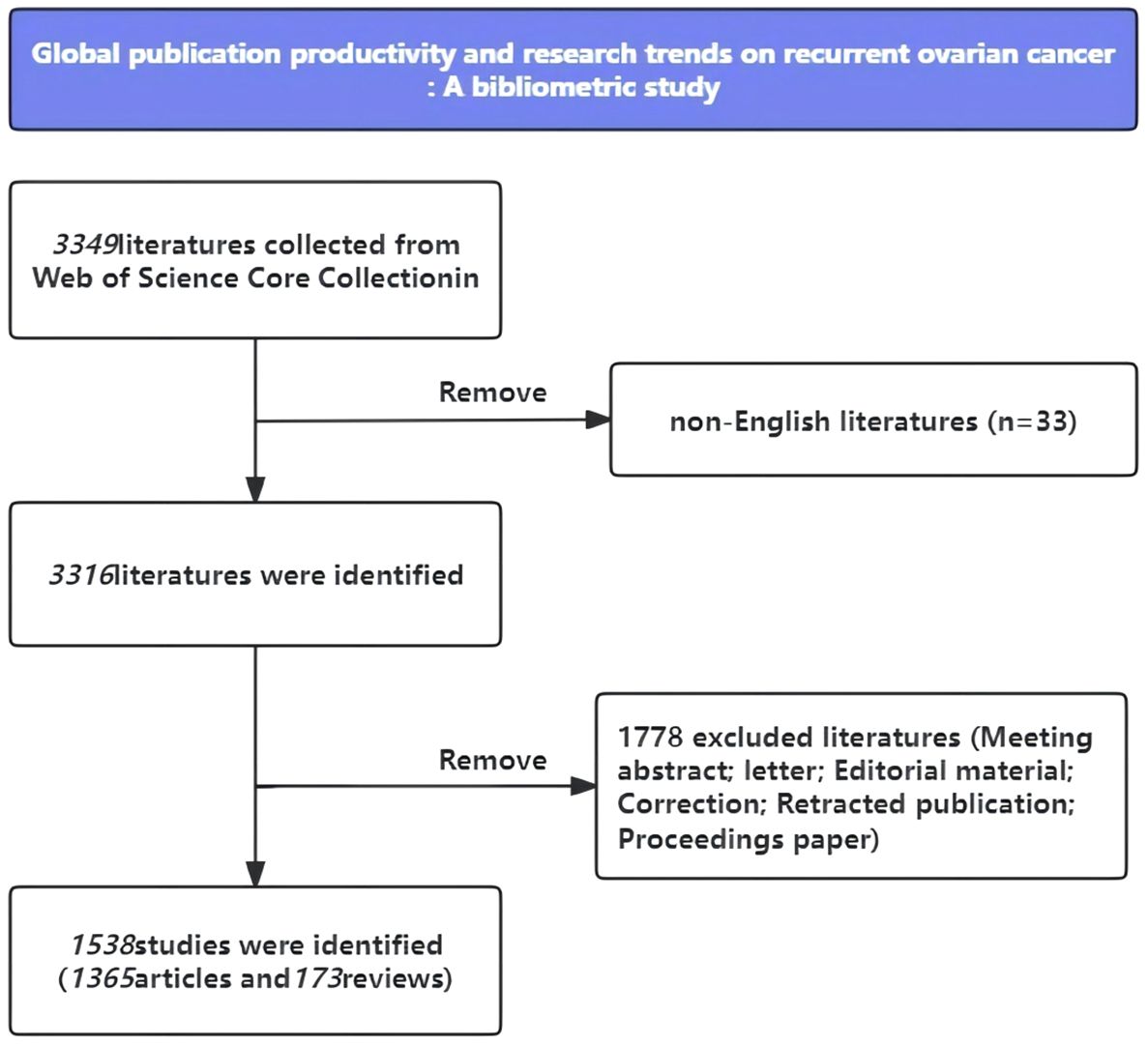
Figure 1 PRISMA flow diagram of the data collection and screening process for the statistic analysis.
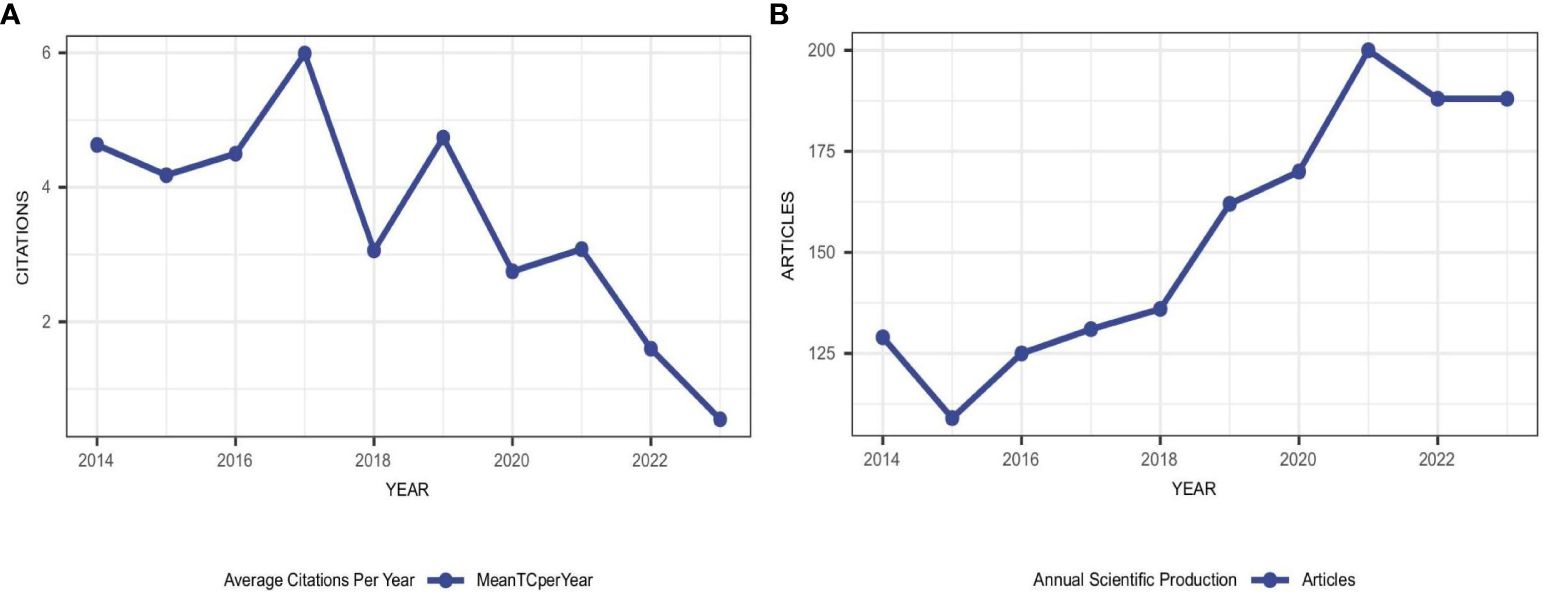
Figure 2 (A) Annual publications output and corresponding growth rate between 2014–2023. (B) The number of average citations per year in recurrent ovarian cancer.
3.2 Sources
A total of 349 journals published one or more documents in this study. Following Bradford’s law (a bibliometric principle) (24), 10 journals were identified as the core sources responsible for publishing one-third of all the retrieved documents (Supplementary Figure 1). Table 1 presented the top 10 most productive journals, along with their corresponding H-index, total citations, and IF/JCR. The most relevant source, “Gynecologic Oncology”, published a total of 192 articles between 2014 and 2023. It was followed by “International Journal of Gynecological Cancer” (n = 113), “European Journal of Gynaecological Oncology” (n = 39), and “Frontiers in Oncology” (n = 33). Among these, “Gynecologic Oncology” was the most popular journal, with a total of 4375 citations and an H-index of 35. In terms of influence, the most prominent periodical was the “Annals of Oncology” with an impressive IF of 50.5, followed closely by the “Journal of Clinical Oncology” with an IF of 45.4. The “International Journal of Gynecological Cancer” also had a notable impact with an IF of 4.8.
3.3 Countries and affiliations
As shown in Figure 3A, a total of 65 countries participated in the study of ROC. These countries refer to the locations of corresponding authors, while the depth of the blue color is related to their scientific production: the higher the production, the bluer the color. It was evident that the USA, China, Japan, and several European countries had a deeper color, indicating higher production levels. Furthermore, we presented the top 10 countries with the highest scientific production in Table 2. The leading country was the USA with 368 publications, accounting for 23.9% of the total publications. Following closely was China with 284 publications, representing 18.5% of the publications. Italy ranked third with 157 publications, accounting for 10.2% of the total. Notably, China was the only developing country on the list. However, when considering the average article citations, France had the highest average with 58.2 citations, followed by the United Kingdom with 40.5 citations, and Canada with 34.3 citations. In contrast, China, despite having the second-highest number of publications, had a relatively low average of article citations with 8.6 citations.
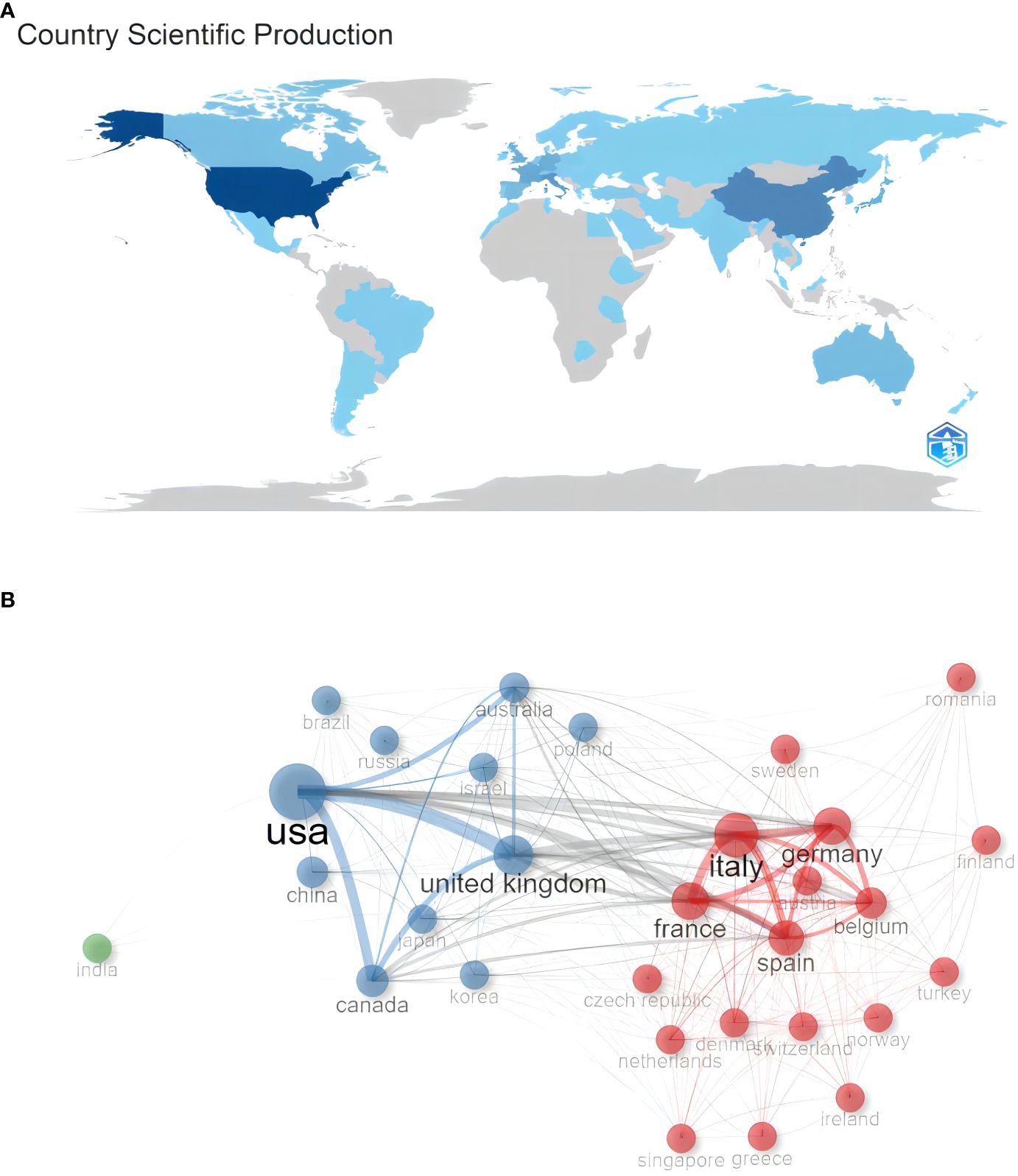
Figure 3 (A) Distribution of publications from different countries/regions in recurrent ovarian cancer. (B) The collaboration network between countries in recurrent ovarian cancer.
Analysis of co-authorship among countries measures the cooperative links based on the number of co-authored documents. Figure 3B depicted the collaboration network of the top 30 most productive countries. It revealed that the USA maintains close relationships with other countries, particularly the United Kingdom. Moreover, there was a noticeable trend of mutual cooperation among European countries, with Italy, France, and Germany collaborating closely. Figure 4 illustrated the publication partnerships in the research field of ROC. The terms “SCP” and “MCP” refer to Single Country Publications and Multiple Country Publications, respectively, indicating the number of papers co-authored by authors of the same or different nationalities. It suggested that international cooperation in this field was quite high, consistent with the findings in Figure 3B. However, it should be noted that the number of publications can influence the quantity of MCP. To evaluate the level of collaboration, the MCP ratio (MCP/SCP) was introduced and presented in the last row of Table 2. Australia exhibits the highest MCP ratio (0.651), followed by the United Kingdom (0.481) and France (0.439).
In terms of institutions, a total of 2,931 institutions contributed to the retrieved articles. Table 3 presented the top 10 institutions based on the number of publications. The University of Texas MD Anderson Cancer Center ranked first with 126 articles, followed by Memorial Sloan Kettering Cancer Center and Fudan University with 123 and 99 articles respectively. Supplementary Figure 2 illustrates the cumulative publications of the top five institutions over a span of 10 years. Notably, Fudan University initiated its study on recurrent ovarian cancer in 2017 and has consistently maintained a high level of scientific output since then.
3.4 Authors
Table 4 presented the top 10 authors with the highest productivity, where SEHOULI J had the highest number of publications with 50 documents. VERGOTE I and SCAMBIA G followed closely with 49 and 47 documents, respectively. Meanwhile, VERGOTE I received the highest total citations among the ten authors, with a total of 9,662 citations. According to Hirsch, the H-index is defined as: “A scientist has index h if h of his or her Np papers have at least H citations each and the other (Np – H) papers have ≤H citations each.” (25). The G-index addresses the limitations of the H-index by considering citation scores for evaluation (26). Generally, the H-index can be used to assess the quantity and impact of a researcher’s scholarly output, while the G-index places greater emphasis on highly cited articles. VERGOTE I (H-index=27), COLOMBO N (H-index=24), and OZA AM (H-index=21) were the top three authors ranked by H-index. Meanwhile, VERGOTE I (G-index=49), SCAMBIA G (G-index=48), and COLOMBO N (G-index=46) had the highest G-index, which was consistent with the results ranked by total citations. Considering the variations in career lengths, the M-index serves as a correction for temporal clues to help identify truly successful researchers (27). By dividing the H-index by the number of years, we obtained a new index called the M-index. Only three authors had an M-index over 2, with the highest M-index belonging to VERGOTE I with 2.5.
In order to investigate the temporal variation of productivity, we used Bibliometrix to obtain a timeline view of the top ten authors with the highest productivity. As shown in Figure 5A, the node size represented the number of articles, and the shade of color represented the total citations. It was evident that most authors consistently published articles during the period of 2014–2023. Figure 5B showed the collaboration network among the top 30 productive authors. The size of the colored blocks represented the number of publications, while the thickness of the lines connecting authors reflected the number of co-authored articles between them. It was obvious that VERGOTE I had the highest degree of collaboration with other authors and SCAMBIA G worked most closely with FAGOTTI A.
3.5 Articles and references
Researchers employ citations to track the evolution of concepts over time and identify papers from a vast array of publications that may hold the greatest value for their research (28). Furthermore, the Local Citation Score (LCS) refers to the count of document citations within a specific dataset. Evidently, articles that receive extensive citations can offer comprehensive insights into scientific progress (29). Publications were ranked in descending order based on their LCS to identify the most valuable articles, as presented in Table 5, which presented the top 10 most local cited articles, comprising 8 original articles and 2 reviews. These articles were primarily published between 2014 and 2019. The article ranked first is “Bevacizumab Combined With Chemotherapy for Platinum-Resistant Recurrent Ovarian Cancer: The AURELIA Open-Label Randomized Phase III Trial.” It was published in the Journal of Clinical Oncology in 2014 with 300 local citations.
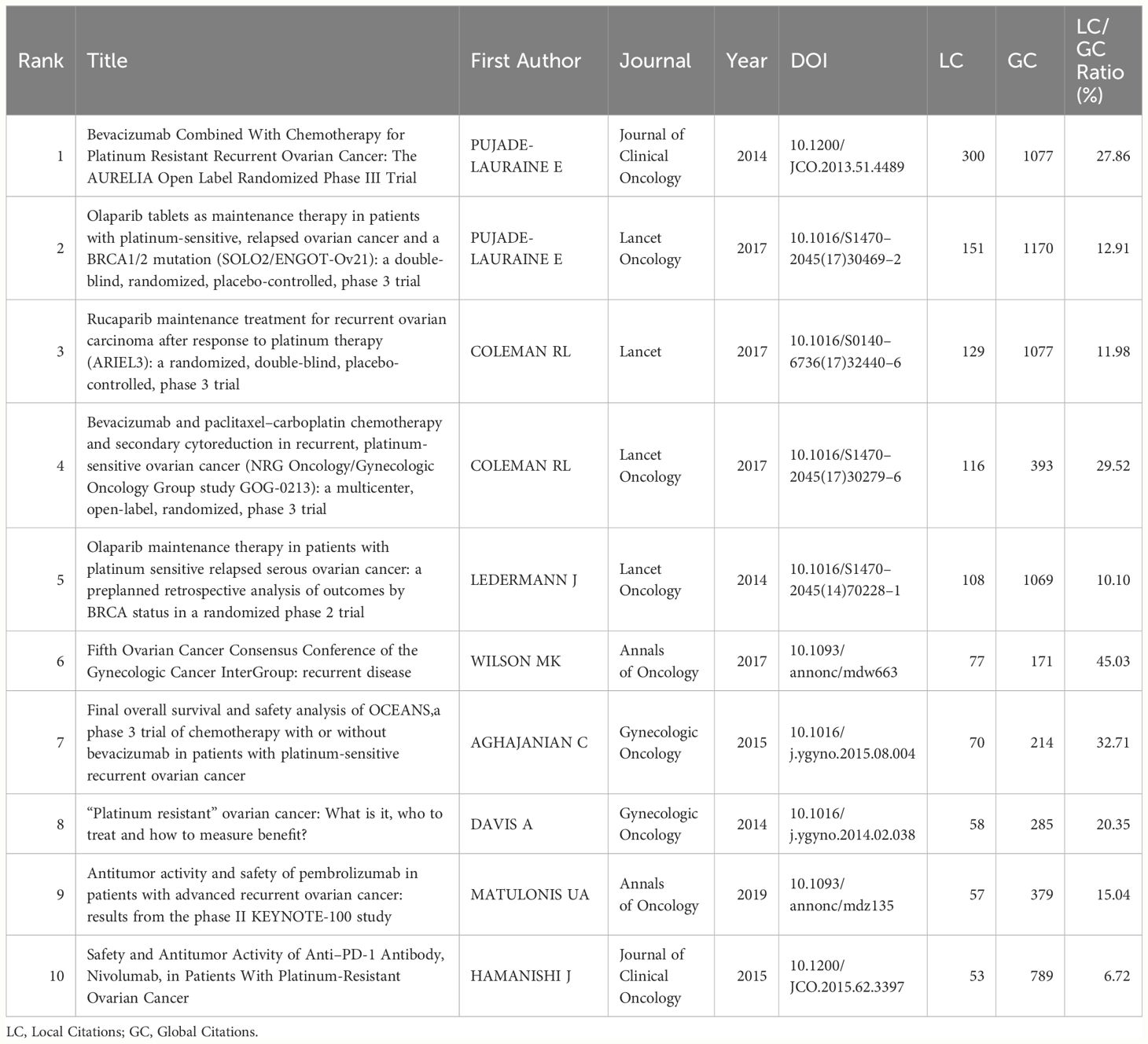
Table 5 The top 10 articles with the most local citation scores in the research field of recurrent ovarian cancer.
In comparison to LCS, the Local Citation Reference (LCR) allows for rapid identification of the most relevant articles in a research field. Table 6 presented the top 10 most local cited references.
3.6 Keywords
Keyword analysis is a process that enables us to accurately identify the hot topics and trends in a specific field (30). Bibliometrix was employed for visualizing the occurrence and frequency of keywords. This study encompassed a total of 2597 keywords proposed by the authors in the articles. After excluding search terms and synonymous keywords, the keyword “chemotherapy” had the highest frequency, occurring 124 times. It was followed by “bevacizumab” with 87 occurrences and “survival” with 65 occurrences. Figure 6A presented the WordCloud after removing the search terms, where the font sizes were proportional to the frequencies of the keywords. In a research paper, When two keywords appeared together in an article, they were referred to as “co-occurrence keywords” and generally had some correlation, which could be expressed through the co-occurrence frequency. The distance between nodes in the network depended on their co-occurrence frequency. Figure 6B displayed a co-occurrence network of the top 50 keywords, and the size of each node represented the total number of co-occurrence occurrences.
The trend topics were displayed in Figure 7, based on the top three keywords that appeared at least 10 times each year. The size of the nodes indicated the frequency of term appearances, while the gray lines represented the duration. Notably, nilarpari and biomarkers made their initial appearance in 2019 and experienced a sudden surge in 2022. Other emerging keywords in the past three years included olaparib, immunotherapy, maintenance therapy, and platinum resistance.
3.7 Themes and thematic evolution
We applied a clustering algorithm to the keyword network and generated a thematic map. The thematic map consisted of mainstream themes, including isolated topics (niche themes), new topics (emerging themes), hot topics (motor themes), and essential topics (basic themes). Each bubble represented a network cluster, with the bubble name determined by the keywords with the highest occurrence value. The size of the bubble was proportional to the occurrence frequency of the cluster’s keywords, and its position was determined based on cluster centrality and density. In the thematic evolution map, the cutting point was fixed at 2019, with different clusters indicated by color coding. The Walktrap algorithm was employed to cluster the data in this study.
The main themes and trends were shown in Figures 8 and 9. The thematic map (Figure 8) indicated that immunotherapy and biomarkers were hot topics, while antibody-drug conjugate and drug resistance were emerging themes. Clinical outcomes (prognosis, survival), chemotherapy, bevacizumab, and PARP inhibitors (olaparib, niraparib) represented the basic and transversal themes. Cytoreduction surgical procedures and tamoxifen were isolated topics. Figure 9 illustrates the major thematic areas and their evolution over two different time periods: 2013 to 2019 and 2019 to 2023, along with their relationships. It primarily demonstrated the transition from “clinical trials,” “neoadjuvant chemotherapy,” “olaparib,” and “recurrence” to “ovarian cancer,” while “DNA methylation” and “ovarian cancer” shifted towards “immunotherapy.”
4 Discussion
We conducted a scientometric analysis of 1,538 publications related to ROC over the past decade. During this period, there was a steady increase in the overall quantity of scientific output. The production of articles grew at an average annual rate of 4.27% and reached its peak in 2021, with only slight negative growth rates observed in 2015 and 2022. Furthermore, the years 2019 and 2021 exhibited relatively high growth rates, indicating a significant surge in research interest in the field. The upward trend indicated that the research field was flourishing. Moreover, the high average citations per article implied that publishing research on recurrent ovarian cancer in reputable journals poses no challenge. Figure 2B suggested that publications in 2017 might have exerted a significant influence on the study of recurrent ovarian cancer. Over the past decade, the mean total citations per article generally declined. While the number of citations is an important metric for assessing academic impact, it is important to acknowledge the influence of time. Earlier studies tended to have a higher likelihood of being cited frequently compared to more recently published ones. Therefore, the academic impact of earlier studies does not necessarily surpass that of later ones (22, 31).
The analysis of countries/regions revealed a widespread distribution of scientific publications across all continents, which reflected the global prevalence of ROC. The leading hubs for scientific production in this field are North America (USA and Canada), Europe (Italy, UK, France, Germany), and Asia (China, Japan, Korea, India). Notably, the United States stood out as the leading country in scientific productions and citations, with 368 papers and a total citations of 12,596. Based on the data provided, it could be firmly concluded that the US was at the forefront of research in this field. Interestingly, China, as the only developing country on the list, demonstrated significant progress in the study of ROC among developing nations. However, China’s average article citations of 8.6 were relatively low. This might be attributed to a focus on quantity rather than quality among Chinese academics (32). In general, research on ROC has been predominantly concentrated in developed countries like the USA. Therefore, the inclusion of China in this list was encouraging for developing countries. It indicated that China has made notable strides in the study of ROC despite the lower average citation count. In the collaboration network, US engaged in collaborations with most countries, and its collaboration with the United Kingdom was particularly close. Additionally, European countries had established extensive collaborations among themselves. According to the institutions’ analysis, the University of Texas MD Anderson Cancer Center ranked first among the top 10 institutions in terms of the number of articles. The list included five institutions from the USA, which was consistent with the countries’ analysis.
The analysis of journals revealed that “Gynecologic Oncology” received the highest number of citations and publications, suggesting that it was the most widely read and popular journal within the field of gynecologic oncology. On the other hand, “Annals of Oncology” ranked first in terms of Impact Factor (IF), indicating that it had the highest average number of citations per published article in the research of ROC. Furthermore, based on Bradford’s Law, a methodology used to determine the core journals in a specific field, a compilation of 10 core journals was presented in Supplementary Figure 1. These core journals were identified as the main contributors to the important publications within the field, indicating that they held significant influence and authority in the research community. The analysis of journals in this manner could be beneficial for researchers as it could provide them with valuable guidance in selecting the most appropriate journals to target for their publications. By understanding the popularity, IF, and core journal rankings, researchers can ensure that their work reaches the right audience and has the potential to make a significant impact in the field of gynecologic oncology research.
In the authors’ analysis, the number and citations of publications were used to evaluate individual authors. SEHOULI J emerged as the leader in terms of the total number of publications. VERGOTE I had the highest H-index and M-index, followed by COLOMBO N. Additionally, VERGOTE I had the highest G-index, followed by SCAMBIA G. It is recommended to focus on VERGOTE I, COLOMBO N, and SCAMBIA G to keep up with significant advances in the field of ROC. Furthermore, based on Figure 5A, it was evident that these ten prolific authors had dedicated a substantial amount of time to this field and continue to produce articles. This suggests that there are still valuable perspectives to explore in the study of ROC, indicating ongoing research opportunities from another standpoint.
In the articles’ analysis, we employed bibliometrix to identify articles with the highest LCS - indicating the most frequently cited articles. Among the top 10 most cited articles, clinical trials dominated, suggesting that the treatment of ROC is still in an exploratory stage. Specifically, Pujade-Lauraine et al. conducted a study in 2014 and found that in patients with platinum-resistant recurrent ovarian cancer, the use of bevacizumab in combination with chemotherapy significantly improved the patients’ progression-free survival (PFS). Their research findings indicated that the hazard ratio for PFS events in patients receiving bevacizumab combined with chemotherapy was 0.48, with a median PFS of 6.7 months, compared to a median PFS of 3.4 months in the chemotherapy-alone group (33). Also in 2014, a study by Jonathan Ledermann et al. found that in platinum-sensitive recurrent ovarian cancer patients with BRCA mutations, the median PFS was 11.2 months for the olaparib group and 4.3 months for the placebo group. It suggested that olaparib might offer greater benefits for patients with BRCA mutations, providing new insights into the personalized treatment of ROC (34).
SOLO2/ENGOT-Ov21 is a double-blind, randomized, placebo-controlled, multicenter, Phase III clinical trial that compared the efficacy of olaparib tablets as maintenance therapy in platinum-sensitive recurrent ovarian cancer patients with BRCA1/2 mutations. Patients were randomly assigned to two groups, with one receiving olaparib tablets and the other receiving placebo, in a ratio of 2:1. The primary endpoint was PFS assessed by the investigators. The results showed a median PFS of 19.1 months in the olaparib group, significantly longer than the placebo group’s 5.5 months (35). In 2017, the clinical trial ARIEL3 found that maintenance therapy with rucaparib significantly prolonged PFS, particularly in patients with BRCA mutations or homologous recombination deficiencies (HRD). The results showed a median PFS of 16.6 months in the rucaparib group compared to 5.4 months in the placebo group for patients with BRCA mutations. In patients with HRD, the median PFS was 13.6 months in the rucaparib group and 5.4 months in the placebo group (36). ARIEL3 provided further evidence that use of a poly(ADP-ribose) polymerase inhibitor in the maintenance treatment setting versus placebo could be considered a new standard of care for women with platinum-sensitive ovarian cancer following a complete or partial response to second-line or later platinum-based chemotherapy. In 2015, Junzo Hamanishi et al. investigated the safety and anti-tumor activity of the anti-PD-1 antibody nivolumab in patients with platinum-resistant ovarian cancer. The study included 20 patients who received intravenous nivolumab treatment, with 80% experiencing side effects, but severe adverse events accounted for only 2%. The best overall response was 15%, including two patients achieving durable complete response. The median PFS was 3.5 months, and the median overall survival (OS) was 20 months. Their study provided evidence for further large-scale trials of anti-PD-1 antibody therapy in ovarian cancer (37).
In 2019, Ursula A. Matulonis et al. conducted a study on the application of pembrolizumab in advanced ROC. The study aimed to evaluate the treatment response of patients to pembrolizumab, a novel therapeutic approach. The study included two cohorts of patients: cohort A received one to three prior lines of treatment with a platinum-free interval (PFI) or treatment-free interval (TFI) between 3 and 12 months, and cohort B received four to six prior lines with a PFI/TFI of ≥3 months. Pembrolizumab was given intravenously every three weeks until disease progression, toxicity, or completion of two years. The primary endpoints were objective response rate (ORR) and PD-L1 expression measured as combined positive score (CPS). Secondary endpoints included duration of response (DOR), disease control rate (DCR), PFS, OS, and safety. The results demonstrated an ORR of 7.4% in cohort A and 9.9% in cohort B, with a median DOR of 8.2 months and not reached, respectively. Additionally, analysis based on PD-L1 expression levels identified ORRs of 4.1% for CPS <1, 5.7% for CPS ≥1, and 10.0% for CPS ≥ 10 (38). This trial indicated a relatively low ORR but a higher DCR with pembrolizumab treatment in ROC. Moreover, patients with a CPS ≥10 exhibited a higher ORR, which could potentially guide future research directions.
Keywords form the essence of a paper summary, as they provide a glimpse into the article’s topic. By analyzing the keywords cloud, it was observed that among the 1,538 articles, excluding the entry terms, “chemotherapy,” “bevacizumab,” and “survival” were the frequently occurring keywords. Figure 7 revealed that chemotherapy and platinum resistance remained prominent subjects, whereas in the past three years, there had been a remarkable surge in research focused on immunotherapy and maintenance therapy, driven by the findings of several clinical trials (33–41). Olaparib and niraparib had emerged as prominent subjects in the management of ROC (39). From 2014 to 2023, themes related to treatment modalities, surgery, and prognosis remained unchanged, encompassing chemotherapy, bevacizumab, and PARP inhibitors. These treatment modalities have consistently played crucial roles in ovarian cancer management, with continuous research in these areas.
Platinum resistance had emerged as a central theme in recent years in ROC, as patients with platinum resistance often have poorer prognoses (42, 43). Hence, “clinical trials” and “antibody-drug conjugates(ADC)” were emerging trends that were likely to occupy a significant position in scientific literature soon (44, 45). ADC has emerged as a fresh form of anticancer therapy. Binding particular antigens on the membrane of tumor cells facilitates deactivation of downstream cancer-causing pathways, thereby provoking immune responses (46). In comparison to conventional chemotherapeutic medications, coupling an antigen-targeting antibody with a cytotoxic medicine enables selective drug delivery to cells expressing the antigen, augmenting effectiveness and minimizing overall toxicity. An ADC consists of a tumor-specific antibody joined with a cytotoxic substance through a molecular linker and will ultimately be internalized and discharged into tumor cells (47). Numerous tumor antigens are differentially expressed in OC cells and can be utilized for this innovative therapeutic strategy. Folate receptor alpha (FRa) is expressed in over 80% of serous ovarian malignant tumors and exhibits no response to chemotherapy (48). Mirvetuximab soravtansine (MIRV) is an ADC specifically designed to target FRa, with its efficacy demonstrated in multiple clinical trials (49–51). As additional therapeutic targets are identified, ADC may potentially offer patients more effective treatment options.
The study’s main limitation is associated with its intrinsic nature. Bibliometric analysis produces quantitative information that may lead to over- or underestimation. Inadequate standardization of items, such as affiliations, can introduce bias into the data. The study’s limited focus only on documents within the WOS database undermines its ability to reflect the complete global research activity on ROC. Additionally, quantitative data, especially the number of citations, may be influenced by the duration for which the publication can accrue references. Furthermore, multiple studies have been updated and published multiple times, reporting on diverse endpoints and various follow-up periods.
5 Conclusion
Research on ROC has been conducted for several decades. The bibliometric study analyzed articles related to ROC between 2014 and 2023, systematically exploring the annual growth trends in publications, journals, countries, institutions, authors, landmark articles, collaborative networks, and keyword analysis. Over the past decade, the focus of research on ROC has shifted from chemotherapy to molecular targeted drugs and immunotherapy. By combining article and keyword analysis, platinum resistance, ADC, and immunotherapy have emerged as the current prominent research topics. Therefore, future research will primarily concentrate on conducting clinical trials of immunotherapy drugs. Additionally, there is an urgent need to explore more sensitive and effective biomarkers to guide targeted therapy effectively.
Data availability statement
The original contributions presented in the study are included in the article/Supplementary Material. Further inquiries can be directed to the corresponding author.
Author contributions
HX: Writing – review & editing, Writing – original draft, Investigation, Funding acquisition, Formal analysis, Data curation, Conceptualization. LW: Writing – review & editing, Writing – original draft, Investigation, Funding acquisition, Formal analysis, Data curation, Conceptualization. DX: Writing – review & editing, Supervision, Software, Methodology, Investigation, Funding acquisition, Formal analysis, Conceptualization.
Funding
The author(s) declare that no financial support was received for the research, authorship, and/or publication of this article.
Conflict of interest
The authors declare that the research was conducted in the absence of any commercial or financial relationships that could be construed as a potential conflict of interest.
Publisher’s note
All claims expressed in this article are solely those of the authors and do not necessarily represent those of their affiliated organizations, or those of the publisher, the editors and the reviewers. Any product that may be evaluated in this article, or claim that may be made by its manufacturer, is not guaranteed or endorsed by the publisher.
Supplementary material
The Supplementary Material for this article can be found online at: https://www.frontiersin.org/articles/10.3389/fonc.2024.1422213/full#supplementary-material
References
1. Siegel RL, Miller KD, Jemal A. Cancer statistics, 2019. CA Cancer J Clin. (2019) 69:7–34. doi: 10.3322/caac.21551
2. Huang J, Chan WC, Ngai CH, Lok V, Zhang L, Lucero-Prisno DE 3rd, et al. Worldwide burden, risk factors, and temporal trends of ovarian cancer: A global study. Cancers (Basel). (2022) 14. doi: 10.3390/cancers14092230
3. Goff BA, Mandel L, Muntz HG, Melancon CH. Ovarian carcinoma diagnosis. Cancer. (2000) 89:2068–75. doi: 10.1002/1097-0142(20001115)89:10<2068::aid-cncr6>3.0.co;2-z
4. Perelli F, Mattei A, Scambia G, Cavaliere AF. Editorial: Methods in gynecological oncology. Front Oncol. (2023) 13:1167088. doi: 10.3389/fonc.2023.1167088
5. Cham S, Chen L, St Clair CM, Hou JY, Tergas AI, Melamed A, et al. Development and validation of a risk-calculator for adverse perioperative outcomes for women with ovarian cancer. Am J Obstet Gynecol. (2019) 220:571.e1–71.e8. doi: 10.1016/j.ajog.2019.02.019
6. Matulonis UA, Sood AK, Fallowfield L, Howitt BE, Sehouli J, Karlan BY. Ovarian cancer. Nat Rev Dis Primers. (2016) 2:16061. doi: 10.1038/nrdp.2016.61
7. Lowe KA, Chia VM, Taylor A, O'Malley C, Kelsh M, Mohamed M, et al. An international assessment of ovarian cancer incidence and mortality. Gynecol Oncol. (2013) 130:107–14. doi: 10.1016/j.ygyno.2013.03.026
8. Romeo M, Gil-Martín M, Gaba L, Teruel I, Taus Á, Fina C, et al. Multicenter real-world data of subsequent chemotherapy after progression to PARP inhibitors in a maintenance relapse setting. Cancers (Basel). (2022) 14. doi: 10.3390/cancers14184414
9. Yuan Z, Zhang Y, Cao D, Shen K, Li Q, Zhang G, et al. Pegylated liposomal doxorubicin in patients with epithelial ovarian cancer. J Ovarian Res. (2021) 14:12. doi: 10.1186/s13048-020-00736-2
10. Nakayama I, Takahari D, Wakatsuki T, Osumi H, Chin K, Ogura M, et al. Single-institute comparison of the efficacy of systemic chemotherapy for oesophagogastric junction adenocarcinoma and stomach adenocarscinoma in a metastatic setting. ESMO Open. (2020) 5. doi: 10.1136/esmoopen-2019-000595
11. Hodgson DR, Dougherty BA, Lai Z, Fielding A, Grinsted L, Spencer S, et al. Candidate biomarkers of PARP inhibitor sensitivity in ovarian cancer beyond the BRCA genes. Br J Cancer. (2018) 119:1401–09. doi: 10.1038/s41416-018-0274-8
12. Foote JR, Secord AA, Liang MI, Ehrisman JA, Cohn DE, Jewell E, et al. Targeted composite value-based endpoints in platinum-sensitive recurrent ovarian cancer. Gynecol Oncol. (2019) 152:445–51. doi: 10.1016/j.ygyno.2018.11.028
13. Wiggans AJ, Cass GK, Bryant A, Lawrie TA, Morrison J. Poly(ADP-ribose) polymerase (PARP) inhibitors for the treatment of ovarian cancer. Cochrane Database Syst Rev. (2015) 2015:Cd007929. doi: 10.1002/14651858.CD007929.pub3
14. van Driel WJ, Koole SN, Sikorska K, Schagen van Leeuwen JH, Schreuder HWR, Hermans RHM, et al. Hyperthermic intraperitoneal chemotherapy in ovarian cancer. N Engl J Med. (2018) 378:230–40. doi: 10.1056/NEJMoa1708618
15. Orbegoso C, Marquina G, George A, Banerjee S. The role of Cediranib in ovarian cancer. Expert Opin Pharmacother. (2017) 18:1637–48. doi: 10.1080/14656566.2017.1383384
16. Jaaback K, Johnson N, Lawrie TA. Intraperitoneal chemotherapy for the initial management of primary epithelial ovarian cancer. Cochrane Database Syst Rev. (2016) 2016:Cd005340. doi: 10.1002/14651858.CD005340.pub4
17. Feng C, Wu Y, Gao L, Guo X, Wang Z, Xing B. Publication landscape analysis on gliomas: how much has been done in the past 25 years? Front Oncol. (2019) 9:1463. doi: 10.3389/fonc.2019.01463
18. Merigó JM, Yang J-B. A bibliometric analysis of operations research and management science. Omega. (2017) 73:37–48. doi: 10.1016/j.omega.2016.12.004
19. Cheng K, Guo Q, Shen Z, Yang W, Wang Y, Sun Z, et al. Bibliometric analysis of global research on cancer photodynamic therapy: focus on nano-related research. Front Pharmacol. (2022) 13:927219. doi: 10.3389/fphar.2022.927219
20. Yeung AWK. Comparison between Scopus, Web of Science, PubMed and publishers for mislabelled review papers. Curr Sci. (2019) 116:1909–+. doi: 10.18520/cs/v116/i11/1909-1914
21. Yeung AWK, Heinrich M, Kijjoa A, Tzvetkov NT, Atanasov AG. The ethnopharmacological literature: An analysis of the scientific landscape. J Ethnopharmacol. (2020) 250:112414. doi: 10.1016/j.jep.2019.112414
22. Wu H, Zhou Y, Xu L, Tong L, Wang Y, Liu B, et al. Mapping knowledge structure and research frontiers of ultrasound-induced blood-brain barrier opening: A scientometric study. Front Neurosci. (2021) 15:706105. doi: 10.3389/fnins.2021.706105
23. Aria M, Cuccurullo C. bibliometrix: An R-tool for comprehensive science mapping analysis. J Informetrics. (2017) 11:959–75. doi: 10.1016/j.joi.2017.08.007
24. Bradford SC. Sources of information on specific subjects. J Inf Science. (1985) 10:173–80. doi: 10.1177/016555158501000406
25. Hirsch JE. An index to quantify an individual's scientific research output. Proc Natl Acad Sci U.S.A. (2005) 102:16569–72. doi: 10.1073/pnas.0507655102
26. Egghe L. Theory and practise of the g-index. Scientometrics. (2006) 69:131–52. doi: 10.1007/s11192-006-0144-7
27. von Bohlen Und Halbach O. How to judge a book by its cover? How useful are bibliometric indices for the evaluation of "scientific quality" or "scientific productivity"? Ann Anat. (2011) 193:191–6. doi: 10.1016/j.aanat.2011.03.011
28. Aksnes DW, Langfeldt L, Wouters P. Citations, citation indicators, and research quality: an overview of basic concepts and theories. SAGE Open. (2019) 9:2158244019829575. doi: 10.1177/2158244019829575
29. Van Noorden R, Maher B, Nuzzo R. The top 100 papers. Nature. (2014) 514:550–3. doi: 10.1038/514550a
30. Dotsika F, Watkins A. Identifying potentially disruptive trends by means of keyword network analysis. Technological Forecasting Soc Change. (2017) 119:114–27. doi: 10.1016/j.techfore.2017.03.020
31. Durieux V, Gevenois PA. Bibliometric indicators: quality measurements of scientific publication. Radiology. (2010) 255:342–51. doi: 10.1148/radiol.09090626
32. Huang F. Quality deficit belies the hype. Nature. (2018) 564:S70–s71. doi: 10.1038/d41586-018-07694-2
33. Pujade-Lauraine E, Hilpert F, Weber B, Reuss A, Poveda A, Kristensen G, et al. Bevacizumab combined with chemotherapy for platinum-resistant recurrent ovarian cancer: the AURELIA open-label randomized phase III trial. J Clin Oncol. (2014) 32:1302–08. doi: 10.1200/jco.2013.51.4489
34. Ledermann J, Harter P, Gourley C, Friedlander M, Vergote I, Rustin G, et al. Olaparib maintenance therapy in patients with platinum-sensitive relapsed serous ovarian cancer: a preplanned retrospective analysis of outcomes by BRCA status in a randomised phase 2 trial. Lancet Oncol. (2014) 15:852–61. doi: 10.1016/s1470-2045(14)70228-1
35. Pujade-Lauraine E, Ledermann JA, Selle F, Gebski V, Penson RT, Oza AM, et al. Olaparib tablets as maintenance therapy in patients with platinum-sensitive, relapsed ovarian cancer and a BRCA1/2 mutation (SOLO2/ENGOT-Ov21): a double-blind, randomised, placebo-controlled, phase 3 trial. Lancet Oncol. (2017) 18:1274–84. doi: 10.1016/s1470-2045(17)30469-2
36. Coleman RL, Oza AM, Lorusso D, Aghajanian C, Oaknin A, Dean A, et al. Rucaparib maintenance treatment for recurrent ovarian carcinoma after response to platinum therapy (ARIEL3): a randomised, double-blind, placebo-controlled, phase 3 trial. Lancet. (2017) 390:1949–61. doi: 10.1016/s0140-6736(17)32440-6
37. Hamanishi J, Mandai M, Ikeda T, Minami M, Kawaguchi A, Murayama T, et al. Safety and antitumor activity of anti–PD-1 antibody, nivolumab, in patients with platinum-resistant ovarian cancer. J Clin Oncol. (2015) 33:4015–22. doi: 10.1200/jco.2015.62.3397
38. Matulonis UA, Shapira-Frommer R, Santin AD, Lisyanskaya AS, Pignata S, Vergote I, et al. Antitumor activity and safety of pembrolizumab in patients with advanced recurrent ovarian cancer: results from the phase II KEYNOTE-100 study. Ann Oncol. (2019) 30:1080–87. doi: 10.1093/annonc/mdz135
39. Poveda A, Floquet A, Ledermann JA, Asher R, Penson RT, Oza AM, et al. Olaparib tablets as maintenance therapy in patients with platinum-sensitive relapsed ovarian cancer and a BRCA1/2 mutation (SOLO2/ENGOT-Ov21): a final analysis of a double-blind, randomised, placebo-controlled, phase 3 trial. Lancet Oncol. (2021) 22:620–31. doi: 10.1016/s1470-2045(21)00073-5
40. Coleman RL, Brady MF, Herzog TJ, Sabbatini P, Armstrong DK, Walker JL, et al. Bevacizumab and paclitaxel–carboplatin chemotherapy and secondary cytoreduction in recurrent, platinum-sensitive ovarian cancer (NRG Oncology/Gynecologic Oncology Group study GOG-0213): a multicentre, open-label, randomised, phase 3 trial. Lancet Oncol. (2017) 18:779–91. doi: 10.1016/s1470-2045(17)30279-6
41. Aghajanian C, Goff B, Nycum LR, Wang YV, Husain A, Blank SV. Final overall survival and safety analysis of OCEANS, a phase 3 trial of chemotherapy with or without bevacizumab in patients with platinum-sensitive recurrent ovarian cancer. Gynecologic Oncol. (2015) 139:10–6. doi: 10.1016/j.ygyno.2015.08.004
42. Bast RC Jr., Hennessy B, Mills GB. The biology of ovarian cancer: new opportunities for translation. Nat Rev Cancer. (2009) 9:415–28. doi: 10.1038/nrc2644
43. Colombo N, Sessa C, du Bois A, Ledermann J, McCluggage WG, McNeish I, et al. ESMO-ESGO consensus conference recommendations on ovarian cancer: pathology and molecular biology, early and advanced stages, borderline tumours and recurrent disease†. Ann Oncol. (2019) 30:672–705. doi: 10.1093/annonc/mdz062
44. Jones J, Pack L, Hunter JH, Valliere-Douglass JF. Native size-exclusion chromatography-mass spectrometry: suitability for antibody-drug conjugate drug-to-antibody ratio quantitation across a range of chemotypes and drug-loading levels. MAbs. (2020) 12:1682895. doi: 10.1080/19420862.2019.1682895
45. Wijdeven MA, van Geel R, Hoogenboom JH, Verkade JMM, Janssen BMG, Hurkmans I, et al. Enzymatic glycan remodeling-metal free click (GlycoConnect™) provides homogenous antibody-drug conjugates with improved stability and therapeutic index without sequence engineering. MAbs. (2022) 14:2078466. doi: 10.1080/19420862.2022.2078466
46. Carter PJ, Lazar GA. Next generation antibody drugs: pursuit of the 'high-hanging fruit'. Nat Rev Drug Discovery. (2018) 17:197–223. doi: 10.1038/nrd.2017.227
47. Beck A, Goetsch L, Dumontet C, Corvaïa N. Strategies and challenges for the next generation of antibody–drug conjugates. Nat Rev Drug Discovery. (2017) 16:315–37. doi: 10.1038/nrd.2016.268
48. Cheung A, Bax HJ, Josephs DH, Ilieva KM, Pellizzari G, Opzoomer J, et al. Targeting folate receptor alpha for cancer treatment. Oncotarget. (2016) 7:52553–74. doi: 10.18632/oncotarget.9651
49. Moore KN, Oza AM, Colombo N, Oaknin A, Scambia G, Lorusso D, et al. Phase III, randomized trial of mirvetuximab soravtansine versus chemotherapy in patients with platinum-resistant ovarian cancer: primary analysis of FORWARD I. Ann Oncol. (2021) 32:757–65. doi: 10.1016/j.annonc.2021.02.017
50. Matulonis U, Lorusso D, Oaknin A, Pignata S, Denys H, Colombo N, et al. Efficacy and safety of mirvetuximab soravtansine in patients with platinum-resistant ovarian cancer with high folate receptor alpha expression: results from the SORAYA study (LBA 4). Gynecologic Oncol. (2022) 166:S50. doi: 10.1016/S0090-8258(22)01297-5
51. Gilbert L, Oaknin A, Matulonis UA, Mantia-Smaldone GM, Lim PC, Castro CM, et al. Safety and efficacy of mirvetuximab soravtansine, a folate receptor alpha (FRα)-targeting antibody-drug conjugate (ADC), in combination with bevacizumab in patients with platinum-resistant ovarian cancer. Gynecologic Oncol. (2023) 170:241–47. doi: 10.1016/j.ygyno.2023.01.020
Keywords: ovarian cancer, recurrent, bibliometrics, R language, Bibliometrix, hot topics
Citation: Xu H, Wang L and Xu D (2024) Global publication productivity and research trends on recurrent ovarian cancer: a bibliometric study. Front. Oncol. 14:1422213. doi: 10.3389/fonc.2024.1422213
Received: 23 April 2024; Accepted: 20 June 2024;
Published: 05 July 2024.
Edited by:
Zhongzhi Wu, University of Tennessee Health Science Center (UTHSC), United StatesReviewed by:
Yang Xie, University of Tennessee Health Science Center (UTHSC), United StatesFederica Perelli, Azienda USL Toscana Centro, Italy
Copyright © 2024 Xu, Wang and Xu. This is an open-access article distributed under the terms of the Creative Commons Attribution License (CC BY). The use, distribution or reproduction in other forums is permitted, provided the original author(s) and the copyright owner(s) are credited and that the original publication in this journal is cited, in accordance with accepted academic practice. No use, distribution or reproduction is permitted which does not comply with these terms.
*Correspondence: Dianbo Xu, eHVkaWFuYm9AZm94bWFpbC5jb20=
†These authors have contributed equally to this work and share first authorship
 Hua Xu†
Hua Xu† Dianbo Xu
Dianbo Xu